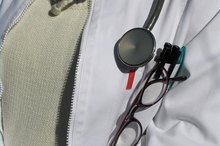Signs of Breast Development
Many girls look forward to the first signs of breast development and view it as a sign that childhood is behind them. As a parent, that moment may seem to arrive too soon, leaving you wondering if your daughter is developing ahead of the curve. While each girl develops at her own rate, knowing what to expect and the age range when it normally occurs makes the transition into puberty easier for both of you.
In the Beginning
Initial breast development begins before birth as the mammary ridge, the nipples and the milk duct system forms. After birth, your daughter’s breasts remain relatively unchanged until she nears puberty. At this time, a tiny swollen lump beneath the nipple begins to form, alerting your daughter that her body is about to change. These lumps, called breast buds, feel firm and are the size of a nickel. Breast buds may form simultaneously beneath both nipples, but uneven development is common, says HealthyChildren.org. Breast buds may be tender and disrupt your daughter’s sleep if she sleeps on her belly.
- Initial breast development begins before birth as the mammary ridge, the nipples and the milk duct system forms.
- After birth, your daughter’s breasts remain relatively unchanged until she nears puberty.
Time for Change
Breast Stages in Puberty
Learn More
Breast buds typically appear between the ages of 9 and 10, but may occur earlier or later. Early breast development is not a concern unless it occurs before the age of 7 in Caucasian girls or before the age of 6 in African-American girls. HealthyChildren.org explains that in the United States, African-American girls reach puberty a year before their Caucasian peers. No reason for the differing ages of puberty onset in the two groups is known.
- Breast buds typically appear between the ages of 9 and 10, but may occur earlier or later.
- Early breast development is not a concern unless it occurs before the age of 7 in Caucasian girls or before the age of 6 in African-American girls.
Changing Bodies
Breast development begins approximately 1.5 to 3 years before menarche, the onset of the first menstrual period. During this time, your daughter’s breasts continue to develop, as breast tissue forms and her body begins to take on the shape of an adult woman. Breast development typically ceases approximately one year after her first menstrual period, says HealthyChildren.org.
- Breast development begins approximately 1.5 to 3 years before menarche, the onset of the first menstrual period.
- Breast development typically ceases approximately one year after her first menstrual period, says HealthyChildren.org.
Asymmetrical Breasts
Breast Bud Development Signs
Learn More
During breast bud formation, the breast often develops at different rates. One breast bud may appear weeks or months before the other. Sometimes this trend leads to uneven breast size, called asymmetrical breasts. The problem typically corrects itself within a year or two, assures HealthyChildren.org. In some cases, plastic surgery may be necessary to create symmetrical breasts.
- During breast bud formation, the breast often develops at different rates.
- One breast bud may appear weeks or months before the other.
Every Girl Reacts Differently
Girls react to the first hint of developing breasts in a variety of ways 1. While some delight in their emerging breasts, others are self-conscious and embarrassed by their changing body. Talk to your daughter and let her know she is developing normally, and alert her to future changes to alleviate unfounded concerns. If you haven’t done so already, discussing menses at this time prepares her for the upcoming transition from child to young woman.
- Girls react to the first hint of developing breasts in a variety of ways 1.
- Talk to your daughter and let her know she is developing normally, and alert her to future changes to alleviate unfounded concerns.
Related Articles
References
- Healthy Children.org : Physical Development in Girls: What to Expect
- Kids Health: Questions and Answers
- Winocour S, Lemaine V. Hypoplastic Breast Anomalies in the Female Adolescent Breast. Semin Plast Surg. 2013;27(1):42–48. doi:10.1055/s-0033-1343996
- Cruz NI. Breast Asymmetry in Women Requesting Plastic Surgery of the Breast. P R Health Sci J. 2018;37(4):230‐238.
- Chen JH, Chan S, Yeh DC, Fwu PT, Lin M, Su MY. Response of bilateral breasts to the endogenous hormonal fluctuation in a menstrual cycle evaluated using 3D MRI. Magn Reson Imaging. 2013;31(4):538-44. doi:10.1016/j.mri.2012.10.022
- Kader T, Hill P, Rakha EA, Campbell IG, Gorringe KL. Atypical ductal hyperplasia: update on diagnosis, management, and molecular landscape. Breast Cancer Res. 2018;20(1):39. doi:10.1186/s13058-018-0967-1
- Hisham A. Juvenile Breast Hypertrophy: A Successful Breast Reduction of 14.9% Body Weight without Recurrence in a 5-Year Follow-Up. Case Rep Surg. Volume 2017, Article ID 3491012. doi:10.1155/2017/3491012
- Kayar R, Çilengiroğlu ÖV. Breast Volume Asymmetry Value, Ratio, and Cancer Risk. Breast Cancer (Auckl). 2015;9:87-92. doi:10.4137/BCBCR.S32789
- Reilley Ann F. Breast Asymmetry: Classification and Management. Aesthetic Surg J. 2006;26(5):596-600. doi:10.1016/j.asj.2006.07.006
- Cruz NI. Breast Asymmetry in Women Requesting Plastic Surgery of the Breast. PR Health Sci J. 2018 Dec;37(4):230-238.
Resources
Writer Bio
Nannette Richford is an avid gardener, teacher and nature enthusiast with more than four years' experience in online writing. Richford holds a Bachelor of Science in secondary education from the University of Maine Orono and certifications in teaching 7-12 English, K-8 General Elementary and Birth to age 5.








